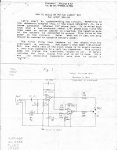Hi there, need some advice from you guys..
Bear in mind I'm falling in the trap of diy... I've never done anything before but a friend of mine (who's got some circuitry blah blah knowledge and can solder!) is willing to help...
I've read a little bit of stuff over the internet about diy di boxes and had eventually found a project that looked interesting to me ( http://web.telia.com/~u31617586/#active DI-box my work horse from 1975 )
I found that buying the transformer required from the UK would cost me about 46£ including shipping (the equivalent of about 66 dollars, not too bad.. and I live in EU so no annoying importing taxes)...
Well, that would be the major expense, and it looks like I'd end up with a good di box...
Now, I've heard that you can do without the transformer and use a dual channel JFET op-amp to make a phantom powered di box instead..
well, considering that for example a 10 pcs lot of TL072CP by texas instrument would cost like 10 dollars including shipping from the US (taxes would be like 2 dollars)... it starts to look interesting...
I mean, it would be way waay cheaper, some say there are even advantages using the opamp active di configuration vs the transformer passive di...
Now I don't know if the TL072CP is the best option out there (if there are better op amps for this particular purpose, I'd be glad if you named them), but if I can build a decent di-box and save loads... why not?
Bear in mind that I'm quite ignorant about all this stuff, so please tell me your thoughts about it but keep it simple... and if someone here knows where I can find some schematics for an op-amp di box with ground lift switch, that would be much appreciated.
Bear in mind I'm falling in the trap of diy... I've never done anything before but a friend of mine (who's got some circuitry blah blah knowledge and can solder!) is willing to help...
I've read a little bit of stuff over the internet about diy di boxes and had eventually found a project that looked interesting to me ( http://web.telia.com/~u31617586/#active DI-box my work horse from 1975 )
I found that buying the transformer required from the UK would cost me about 46£ including shipping (the equivalent of about 66 dollars, not too bad.. and I live in EU so no annoying importing taxes)...
Well, that would be the major expense, and it looks like I'd end up with a good di box...
Now, I've heard that you can do without the transformer and use a dual channel JFET op-amp to make a phantom powered di box instead..
well, considering that for example a 10 pcs lot of TL072CP by texas instrument would cost like 10 dollars including shipping from the US (taxes would be like 2 dollars)... it starts to look interesting...
I mean, it would be way waay cheaper, some say there are even advantages using the opamp active di configuration vs the transformer passive di...
Now I don't know if the TL072CP is the best option out there (if there are better op amps for this particular purpose, I'd be glad if you named them), but if I can build a decent di-box and save loads... why not?
Bear in mind that I'm quite ignorant about all this stuff, so please tell me your thoughts about it but keep it simple... and if someone here knows where I can find some schematics for an op-amp di box with ground lift switch, that would be much appreciated.

 That's why those are advantages of a transformer.
That's why those are advantages of a transformer.

